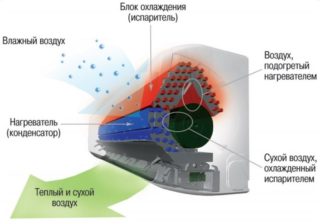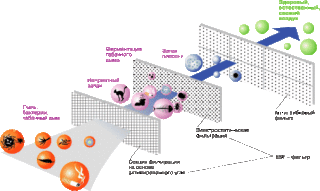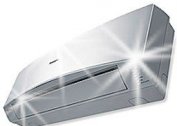Modern air conditioners have a lot of useful functions - cooling, heating, ionization of the air. Thanks to them, the well-being and health of residents improves. However, owners of split systems sometimes notice allergic reactions during device operation. It is worthwhile to understand why there is an allergy to air conditioning and how to fix the situation.
Allergy Symptoms
 Under the influence of split systems, a person can feel a lot of unpleasant manifestations. Symptoms of an allergy to air conditioning:
Under the influence of split systems, a person can feel a lot of unpleasant manifestations. Symptoms of an allergy to air conditioning:
- Shortness of breath and nasal congestion in the chest area.
- Constant coughing and sneezing, after which there is no feeling of relief.
- Conjunctivitis of an allergic nature, manifested by inflammation of the mucous membrane of the eye. Runny nose, in which a large volume of transparent mucus flows from the nose.
- It is difficult for a person to look at the light; he experiences a burning sensation in his eyes and tearing.
- The appearance of a rash. It can have a different character and is often accompanied by itching.
By observing the rules for operating the air conditioner, you can avoid allergic reactions and maintain health. In cases where any of these symptoms appear, you should consult a specialist and get treatment. After that, the split system is cleaned and repaired.
Causes of the disease
It is worth identifying the causes of allergies in a person living in an apartment with air conditioning.
Air drying
Excessively dry air affects the skin condition - it blushes and peels. Mucous nasopharynx lose moisture and become thinner. Allergic reactions cause severe discomfort.
 The air conditioner is not able to dry the air in the room enough to cause such symptoms. On the contrary, it brings the moisture indicator to a level at which mold, the main allergen, cannot reproduce. The drying effect of the conditioner affects only very sensitive skin. Since the epidermis of children is more vulnerable, an allergy to air conditioning in a child due to dry air is more likely.
The air conditioner is not able to dry the air in the room enough to cause such symptoms. On the contrary, it brings the moisture indicator to a level at which mold, the main allergen, cannot reproduce. The drying effect of the conditioner affects only very sensitive skin. Since the epidermis of children is more vulnerable, an allergy to air conditioning in a child due to dry air is more likely.
High humidity
In addition to excessive dryness, allergies can also provoke high humidity. The dampness in the room promotes the growth of mold and other types of fungi. They spread their disputes around the apartment, and reduce immunity when ingested. Ionizers can help reduce humidity - stand-alone devices or built-in air conditioners.
Temperature differences
A sharp change in temperature can cause hypothermia. The coolness produced by the air conditioner often causes a stressful state of the body. This happens when a person enters a room with a temperature of 20 degrees from a 30-degree heat.
By avoiding extreme adjustments to the thermometer, allergy symptoms can be prevented. Lower the temperature should be 2-3 degrees every half hour, gradually bringing the indicator to the desired level.
Colds
Symptoms of the common cold often resemble allergic reactions. In cooling mode, cold air masses exit the split system. If you sit or stand in the immediate vicinity of the device for a long time, the first signs of a cold can resemble an allergy.
High dust concentration
After installing the air conditioner, homeowners rarely ventilate the room. As a result, the same air circulates around the room. He becomes stale, creates a feeling of stuffiness. In such air, the concentration of dust and pollen of domestic plants is much higher. These conditions adversely affect the skin of every child and adult.
Chemicals for air conditioning
For cooling and heating air in air conditioners use freons and some polyhydric alcohols.With proper operation of the split system, nothing enters the air masses. However, vapors of cooling substances can leak into the air in a small amount and enter the body of residents. An allergy to freon conditioner is manifested by cough, nausea, dry throat and an asthmatic attack.
The condition of the sealed tubes of the air conditioner must be checked regularly. In the event of refrigerant leakage, damaged components will be repaired immediately. Such measures can maintain health and increase the life of the equipment.
Filter problem
 Each air conditioner contains coarse and fine filters. The first catches large debris, cobwebs and plant seeds. A fine filter traps fine dust, pollen, and tobacco smoke. These filters become dirty over time, which reduces the efficiency of the processor. After several months of operation of the split system, a large amount of dust accumulates on the filters, which contains viruses, bacteria and fungi.
Each air conditioner contains coarse and fine filters. The first catches large debris, cobwebs and plant seeds. A fine filter traps fine dust, pollen, and tobacco smoke. These filters become dirty over time, which reduces the efficiency of the processor. After several months of operation of the split system, a large amount of dust accumulates on the filters, which contains viruses, bacteria and fungi.
Microorganisms deposited on the cleaning elements actively multiply (especially in humid air). If you turn on the air conditioner after a long period of inactivity, they are thrown into the room, causing allergic reactions in people.
Factors contributing to the appearance of allergies if there is air conditioning in the house:
- a powerful device serves a small room;
- the apartment owner rarely cleans the filters;
- For a long time, the split system was not repaired.
Thus, air conditioners alone are not capable of causing allergies. Coughing, dry mucous membranes and redness of the skin appear only if the device is used improperly.
Air conditioning filters for allergy sufferers
Air conditioning for allergy sufferers should have an inverter motor capable of changing the speed. This allows you to switch the device to different operating modes. The system filters the air in several stages for maximum cleaning. It is worth considering the main types of filters.
Photocatalytic
The principle of operation of the filter resembles the work of a finely porous coal element. However, it includes special additives that eliminate various odors that trap microorganisms and chemicals for 3-5 years.
Zeolite filters are washed and dried every 1000 hours of operation. After cleaning, they are placed in direct sunlight for 3-4 hours.
Titanium oxide-based photocatalytic filters serve less, but clean the air more efficiently. They have to be changed every year. They must not be washed, but must be taken out in the sun every 300 hours of operation.
Plasma
 In plasma filter elements, air is ionized, subjected to a voltage of several thousand volts. Dust particles get a charge. When passing an electrostatic filter of opposite polarity, they are delayed.
In plasma filter elements, air is ionized, subjected to a voltage of several thousand volts. Dust particles get a charge. When passing an electrostatic filter of opposite polarity, they are delayed.
The advantage of plasma filters is that particle sizes do not matter. The quality of cleaning the air conditioner depends on the strength of the charge received by the particle and the ability to stick together with others similar to it.
Plasma filters do not need to be changed and cleaned, and their efficiency reaches 95%. These indicators indicate the high efficiency of such elements in the elimination of organic and inorganic allergens.
Antibacterial
The effectiveness of split systems for allergy sufferers increased when equipped with antibacterial filters. Microorganisms are captured and then destroyed. Microbes do not multiply and do not penetrate the room.
Catechin filter is one of the types of antibacterial cleaners. It neutralizes both bacteria and viruses, decomposing them into radicals. The antibody filter is capable of cleaving fungal spores and protozoa.
A deodorizing filter is used as an addition to the main cleaning system. It has a large surface area, which allows you to effectively eliminate smoke and odors. Such air conditioning is especially effective in the home of smokers.
Thus, it is better for allergy sufferers to choose inverter air conditioners equipped with a full-stage filtration system. One of the main functions of the split system is to maintain the specified parameters of air humidity. Such devices maintain an optimal indoor climate.


